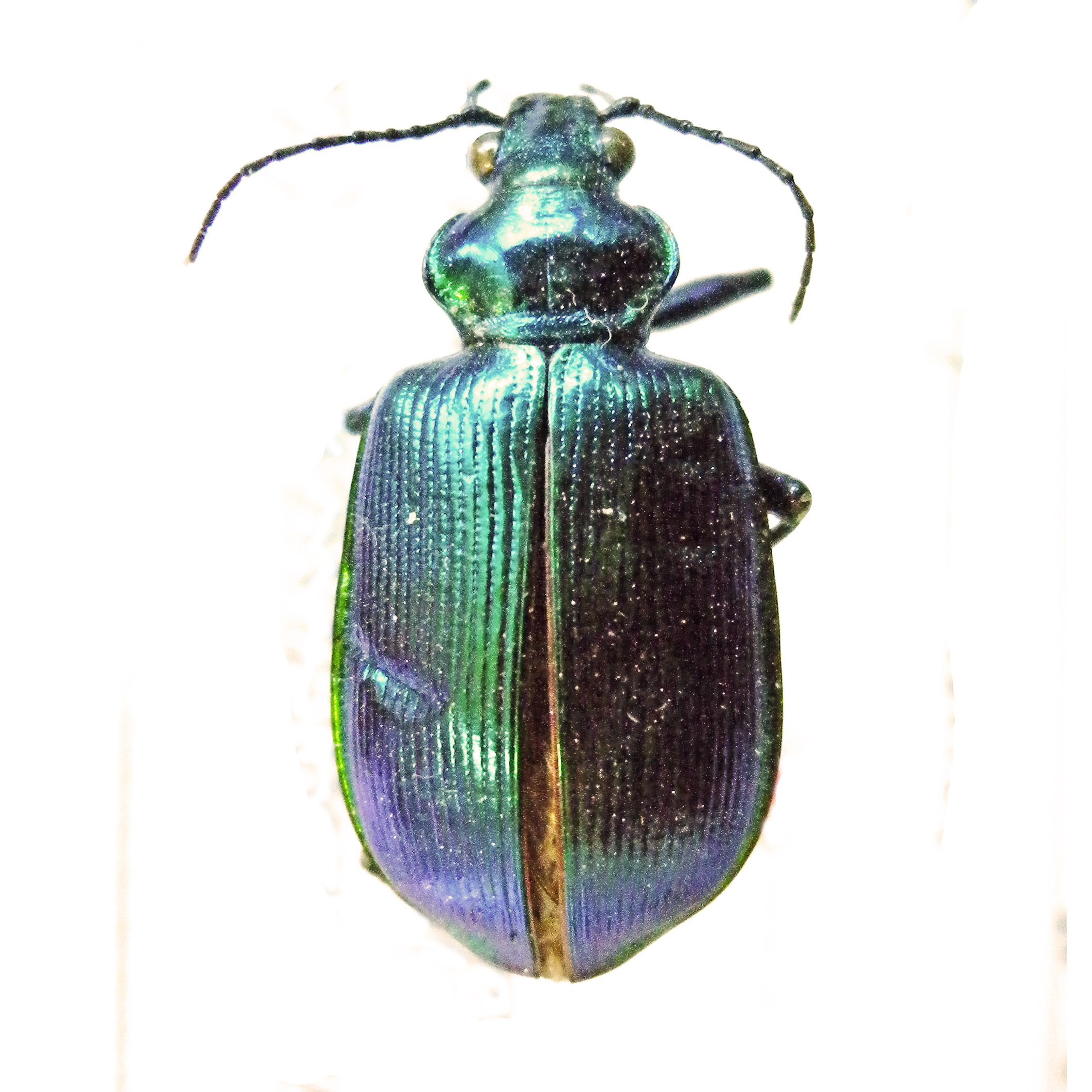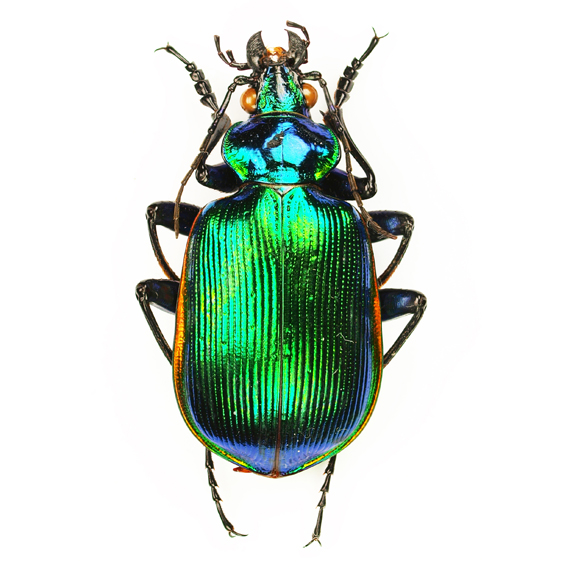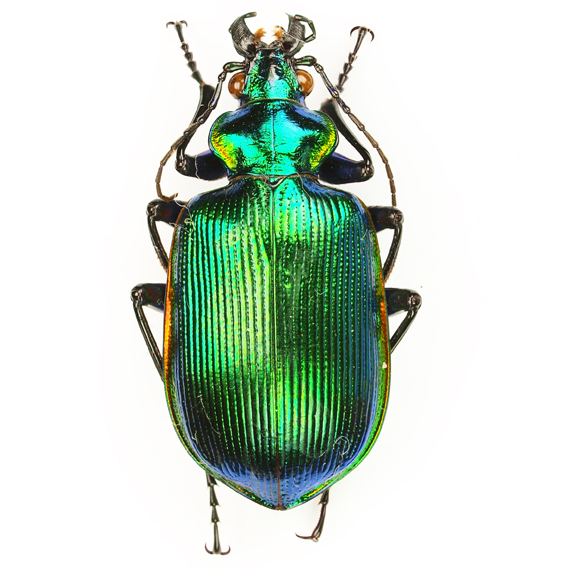Calosoma (Calodrepa) aurocinctum Chaudoir, 1850
Calosoma aurocinctum Chaudoir, 1850: 420 (type locality: Mexique); lectotype ♀ designated by Deuve (1978: 248) in Muséum National d'Histoire Naturelle, Paris [examined]
Calosoma (Calosoma) aurocinctum Breuning, 1927a: 162
Calosoma (Calodrepa) aurocincta Lapouge, 1932: 405
Calodrepa aurocinctum Jeannel, 1940: 78
Calosoma (Calodrepa) aurocinctum Gidaspow, 1959: 248
Calosoma (Calosoma) aurocinctum Erwin, 2007: 89
Length 22-27 mm. C. aurocinctum has the entire upper side of the body of a bright green color; moreover, as the name suggests, it is well characterized by a purple or golden green border along the lateral margin of the elytra. From C. scrutator , that has similar color pattern on the elytra, C. aurocinctum can be distinguished by its pronotum that is narrowed behind with sparse punctures at its base, of an uniform metallic green color, sometimes with a slightly lighter border.
C. aurocinctum is an essentially Mexican species widespread along the entire coast of the Gulf of Mexico, starting from the terminal portion of the Rio Grande. It is also present on the left bank of the river, in Texas, where in recent years it seems to have significantly extended its distribution area. To the south it reaches the Yucatán Peninsula, including the state of Petén in Guatemala, from where it was recently reported. It is rare or absent in the North and Central Mexican Plateau and sporadically found on the south western slopes of the Sierra Madre Occidental.
The possible diffusion of this species in Central America is doubtful. Gidaspow (1963: 283) had indicated its presence in Nicaragua without specifying any exact place and this indication was discussed and considered possible by Erwin (1991: 26; 2007: 899). It has recently been cited again from Nicaragua on the basis of the uncertain determination of some remains found in the feces of a gray fox (Muñoz & Maes, 2015: 5) but this citation must be corrected and such remains should be attributed to C. scrutator (Van Den Berghe, 2016: 6).
Examined specimens and literature’s data
Guatemala. Petén: Cerro Cahuí (www.inaturalist.org)
Mexico. Aguascalientes: Jesús María (www.inaturalist.org); Campeche: Edzna ruin (GP, EM), Champoton sea shores (AVT), Seybaplaya, Calakmul, Xpujil (www.inaturalist.org); Chiapas: (AVT, EM), Merida, Palenque (www.inaturalist.org); Chihuahua: Minaca, Magiscatzin (UASM); Durango: Sierra de Durango (Breuning, 1927: 162); Sierra de la Silla (http://carabidae.org), Coscomate (www.inaturalist.org); Jalisco; Mezquitic (www.inaturalist.org); Mexico: Malinalco (www.inaturalist.org); Morelos: 5 mi. W Antigua (SB), Cuernavaca Piramide (Gidaspow, 1959: 248); Nuevo Leon: Tamauli pass (GP), Allende, Apodaca, Santiago, Monterrey (Gidaspow, 1959: 248), Juárez, San Nicolás de los Garza, Santiago,Guadalupe, Pesquería, Gral Zuazua, Linares (www.inaturalist.org); Oaxaca: Oaxaca (GP), Salina Cruz (Gidaspow, 1959: 248), Selva de los Chimalapas (Ebay 2020), Villa de Etla (www.inaturalist.org); Quintana Roo: Quintana Roo (GP), Nuevo Durango (SB), Felipe Carrillo Puerto, Benito Juárez, Chunyaxché (www.inaturalist.org), Cozumel Island (Ebay 2020); San Luis Potosi: Ciudad Valles (SB); Sinaloa (VV); Tabasco: Villa El Triunfo (www.inaturalist.org/observations/7127060); Tamaulipas: Ciudad Victoria (EM), Rio Sabinas, Magiscatzin, Villa Manuel, Villagran, Ciudad Mante (UASM), 26 ml N Gonzalez 650m (TAMUIC), Tampico (Breuning, 1927: 163), San Fernando, Gómez Farias, Llera (www.inaturalist.org); Vera Cruz: Los Tuxtlas (SB), Playa Vicente (Breuning, 1927: 163), Monte Morelos (Gidaspow, 1959: 248); Yucatan: Pisté (AVT, EM), Chichen Itzà (AVT), X-can (AVT), Merida (Gidaspow, 1959: 248), Tizimín, Maní, Celestún, Sisal, Mapsa, Colonia Yucatán, Homun, Dzilam González, Sucilá (www.inaturalist.org), Lac des Iles (www.inaturalist.org); Zacatecas: El Chiquihuite (www.inaturalist.org)
United States. Texas. Cameron County: Laguna Atascosa, 2.4 miles E Palmito Hill (TAMUIC), Sabal Palm Grove Re:fuge (www.gbif.org/), Brownsville (Burgess & Collins, 1917: 122; SB), La Feria, Las Palomas WMA, Harlingen, San Benito (www.inaturalist.org); Hidalgo County: Sal Del Rey Wildlife Refuge, Santa Ana Wildlife Refuge, Estero State Park, Edinbourg (www.inaturalist.org), 16 km SE McAllen (bugguide.net); San Patricio County: Lake Corpus Christi SP (www.inaturalist.org); Nueces co: Corpus Christi (www.inaturalist.org); Kleberg County: Kingsville (www.inaturalist.org); Webb County: Laredo, Oilton env. (www.inaturalist.org); Zapata County: Falcon Mesa (www.inaturalist.org); Starr County: Falcon State Park, Los Alvarez (www.inaturalist.org).
Notes: C. aurocinctum is winged, diurnal and nocturnal, attracted to light at night. sometimes very abundant in coincidence with the hatching of the caterpillars of which it feeds. It is found in various types of habitats, such as grasslands and groves. Active individuals were observed mostly during the raining season from May to August, and rarely up to October.
Perbosc (1839: 261) had incorrectly identified some specimens of this species with Calosoma splendidum Dejean, 1831, aiming to integrate the original description. For this reason Calosoma splendidum Perbosc, 1839 (nec Dejean 1831) has sometimes been cited (Bates, 1881: 20) among the synonyms of Calosoma aurocinctum, but it is superflous as Perbosc, attributing his Calosoma splendidum to Dejean, did not propose a new species.
 Chaudoir, 1850 Mexique (lectotype) (Muséum National d'Histoire Naturelle, Paris) |
 Chaudoir, 1850 Mexico: Nuevo Leon, Tamauli pass , 10.V.1971 |
 Chaudoir, 1850 Mexico: Nuevo Leon, Tamauli pass , 10.V.1971 |